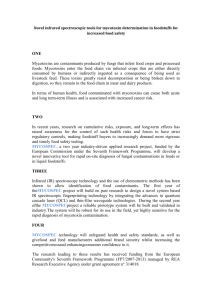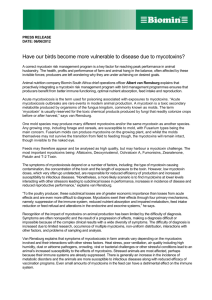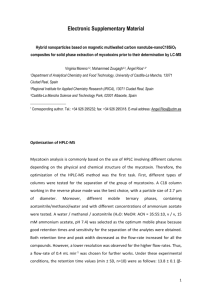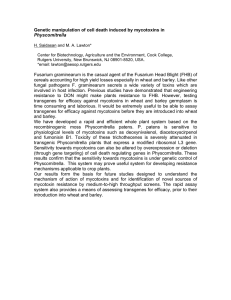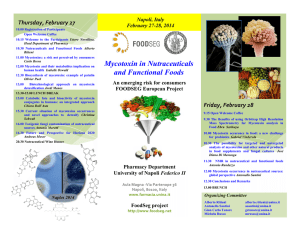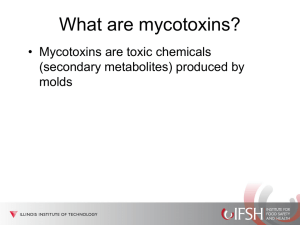Immunosuppression caused by mycotoxins – the hidden enemy
advertisement
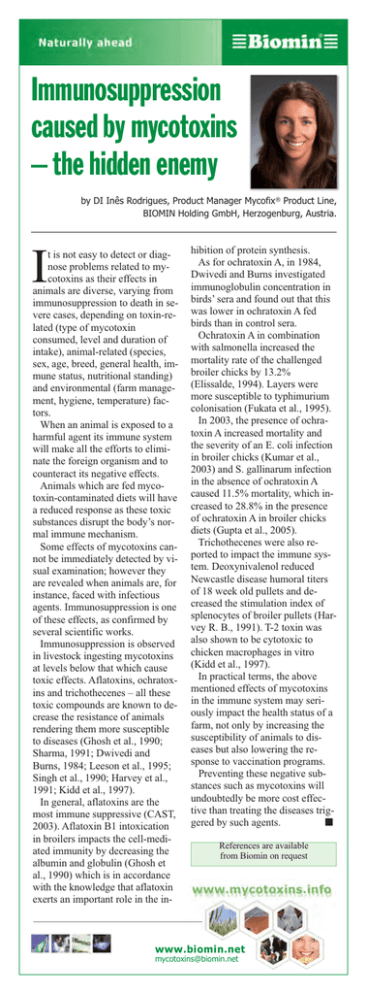
Immunosuppression caused by mycotoxins – the hidden enemy I by DI Inês Rodrigues, Product Manager Mycofix® Product Line, BIOMIN Holding GmbH, Herzogenburg, Austria. t is not easy to detect or diagnose problems related to mycotoxins as their effects in animals are diverse, varying from immunosuppression to death in severe cases, depending on toxin-related (type of mycotoxin consumed, level and duration of intake), animal-related (species, sex, age, breed, general health, immune status, nutritional standing) and environmental (farm management, hygiene, temperature) factors. When an animal is exposed to a harmful agent its immune system will make all the efforts to eliminate the foreign organism and to counteract its negative effects. Animals which are fed mycotoxin-contaminated diets will have a reduced response as these toxic substances disrupt the body’s normal immune mechanism. Some effects of mycotoxins cannot be immediately detected by visual examination; however they are revealed when animals are, for instance, faced with infectious agents. Immunosuppression is one of these effects, as confirmed by several scientific works. Immunosuppression is observed in livestock ingesting mycotoxins at levels below that which cause toxic effects. Aflatoxins, ochratoxins and trichothecenes – all these toxic compounds are known to decrease the resistance of animals rendering them more susceptible to diseases (Ghosh et al., 1990; Sharma, 1991; Dwivedi and Burns, 1984; Leeson et al., 1995; Singh et al., 1990; Harvey et al., 1991; Kidd et al., 1997). In general, aflatoxins are the most immune suppressive (CAST, 2003). Aflatoxin B1 intoxication in broilers impacts the cell-mediated immunity by decreasing the albumin and globulin (Ghosh et al., 1990) which is in accordance with the knowledge that aflatoxin exerts an important role in the in- hibition of protein synthesis. As for ochratoxin A, in 1984, Dwivedi and Burns investigated immunoglobulin concentration in birds’ sera and found out that this was lower in ochratoxin A fed birds than in control sera. Ochratoxin A in combination with salmonella increased the mortality rate of the challenged broiler chicks by 13.2% (Elissalde, 1994). Layers were more susceptible to typhimurium colonisation (Fukata et al., 1995). In 2003, the presence of ochratoxin A increased mortality and the severity of an E. coli infection in broiler chicks (Kumar et al., 2003) and S. gallinarum infection in the absence of ochratoxin A caused 11.5% mortality, which increased to 28.8% in the presence of ochratoxin A in broiler chicks diets (Gupta et al., 2005). Trichothecenes were also reported to impact the immune system. Deoxynivalenol reduced Newcastle disease humoral titers of 18 week old pullets and decreased the stimulation index of splenocytes of broiler pullets (Harvey R. B., 1991). T-2 toxin was also shown to be cytotoxic to chicken macrophages in vitro (Kidd et al., 1997). In practical terms, the above mentioned effects of mycotoxins in the immune system may seriously impact the health status of a farm, not only by increasing the susceptibility of animals to diseases but also lowering the response to vaccination programs. Preventing these negative substances such as mycotoxins will undoubtedly be more cost effective than treating the diseases triggered by such agents. n References are available from Biomin on request www.biomin.net mycotoxins@biomin.net Gangrenous dermatitis (necrotic dermatitis) G by Gino Lorenzoni, DVM, MSC, PhD, Technical Manager, BIOMIN Holding GmbH, Herzogenburg, Austria. angrenous dermatitis is an acute infection of the subcutaneous tissue of broilers and turkeys. In the USA this poultry disease causes severe economic losses due to mortality ranging from 1 to 2% per week in affected turkey operations (Thachil et al., 2010). Gangrenous dermatitis has been associated with the isolation of different bacteria from the subcutaneous lesions: C. perfringens, C. septicum, C. sordellii, S. aureus, and E. coli (Ficken, 1991). Experimental necrotic dermatitis can be reproduced by injecting the listed bacteria subcutaneously with C. septicum being the most effective to induce the experimental lesions (Jeffrey et al., 2001; Tellez et al., 2009; Thachil et al., 2010). For this reason, gangrenous dermatitis has been linked to the contamination of skin lesions often associated with low feeder and drinker space. As with many poultry diseases, gangrenous dermatitis is also associated with immune suppressing diseases such as the infectious bursal disease. Actually, measures to control immune suppressive diseases in a flock will often produce a reduction in the incidence of gangrenous dermatitis (Willoughby et al., 1996). Despite the general belief that necrotic dermatitis is primarily caused by contaminated skin lesions, several producers have reported continuous outbreaks of the disease even after ameliorating immune suppressing diseases, correcting bird density and supplying generous feeder and drinker space. Trials conducted by Biomin with the collaboration of the USDA with the synbiotic PoultryStar have shown amelioration of necrotic enteritis in broilers reared in commercial facilities with a history of recurrent outbreaks of necrotic dermatitis. The authors attribute the reduction of mortality due to an improved general health condition of the birds treated with probiotics (Waneck et al., 2009). Recently, necrotic dermatitis has been experimentally reproduced in turkeys following a single intravenous inoculation of C. septicum (Tellez et al., 2009). The experimental disease was also reproduced with a combined intravenous inoculation of C. septicum and C. perfringens. Interestingly, a cell free culture of C. septicum induces neurological signs after injection but fails to produce skin lesions or mortality in turkeys indicating that viable bacteria but not the toxins alone are responsible for the disease. Development of the disease via intravenous inoculation of the causative agent opens a door for developing new theories that explain the pathogenesis of the disease. It could be possible that under favourable conditions intestinal bacteria could leak through the intestinal tract and via the systemic circulation reach subcutaneous tissues generating the disease when the bacteria find the appropriate environment. Actually, lesions have been related to bruised areas on the skin which could be explained by changes in the micro environment of the subcutaneous tissue favouring the replication of the bacteria (Tellez et al., 2009).n References are available From Biomin on request www.biomin.net probiotics@biomin.net New strategy for sustainable poultry production N by Marco Aurélio de Sousa, DVM, MSc, Biomin Holding GmbH, Herzogenburg, Austria. marco.sousa@biomin.net owadays with the constant increase of grain prices, feed conversion ratio plays a role in the costs of production and significantly exerts influence in the price of the final product. To enhance feed conversion, additives are commonly incorporated in feeding stuffs, although the right choice on what to use should be carefully examined. Wrong decisions might generate additional production costs. To avoid frustrations the decision maker must choose with reference to products which have been properly tested, authorised and their efficacy documented. Furthermore, inappropriate use of additives may promote adverse consequences on animal health and on consumers of livestock products. Animals fed with supplementation of essential oils Biomin P.E.P. demonstrated improved feed conversion rates and a higher Production Index at scientific and field experiments. Thus, Biomin P.E.P. assists in optimising poultry production. Enhancement of cost efficiency and its increase in profitability are due to the higher weight gain and better FCR. Biomin P.E.P. is a plant derived product which is added to the feed in order to improve digestibility and growth performance. These plant active ingredients exert multiple effects in the animal, including amelioration of feed efficiency in terms of modulation of gut flora and health status. The mechanism of action of essential oils to achieve better performance is not completely clear but according to Ultee et al (2002) and Xu et al (2008) essential oils have the ability to disrupt cytoplasm membrane of pathogens. Moreover, antibacterial activity occurs in terms of ac- www.biomin.net phytogenics@biomin.net tive substances of essential oils which might cross the cell membrane and interact or disrupt intracellular structures (Cristani et al. 2007). A positive effect towards the intestinal microflora is therefore regarded as a main reason for improvements in growth performance, limiting nutrient utilisation by gut microbes and providing more available nutrients for the bird. Besides performance enhancer properties, Biomin P.E.P. has also shown strong antioxidant and antimicrobial properties. Among its properties, it improves the establishment of a beneficial gut microflora in the digestive tract to prevent the gut from invasion by pathogenic organisms. Biomin P.E.P. reduced intestinal lesion scores and lowered the mortality of clostridium infected birds, hence providing the poultry industry with a tool to promote better gut health and decrease monetary losses due to bacterial infections. Controlling intestinal diseases with phytogenics is the key to raising chickens without antibiotics at reduced costs. Improvement in performance is a result of the different properties of Biomin P.E.P. The benefits of Biomin P.E.P. are due to its synergism among ingredient’s mode of action where the different animal responses to the treatment interact with each other and consequently enhance animal health and its productivity. Analysis of safety, quality and efficacy of Biomin P.E.P. was demonstrated in the form of evidence based scientific publications. n References are available from Biomin on request Mycotoxin interactions V by Karin Naehrer, Technical Manager, Biomin Holding GmbH, Herzogenburg, Austria. karin.naehrer@biomin.net arious feedstuffs are at risk to fungal infection and might, consequently, be contaminated with mycotoxins; the secondary metabolites produced by different mould species. Mycotoxin contaminated grains can cause a great deal of problems in poultry production varying from immune suppression to death in severe cases, depending on toxin-related (type of mycotoxin consumed, level and duration of intake), animal-related (sex, age, breed, general health and immune status) and environmental (farm management, hygiene and temperature) factors. In many cases, animals do not perform as well as they could or as it would be expected based on the breed’s characteristics. In addition, veterinarians often try to cure secondary symptoms which appear, but often mycotoxins are one of the primary reasons for an impaired performance of the animal. Moulds are capable of simultaneously producing several mycotoxins resulting in a natural contamination of grain with different mycotoxins. According to the 2009 Biomin survey program on the worldwide occurrence of mycotoxins, 75% of the analysed samples were contaminated with at least one mycotoxin. In 40% of all analysed samples, more than one mycotoxin was detected (Rodrigues and Griessler, 2010). Similar results were presented by Monbaliu et al. (2010) in a survey of mycotoxin occurrence in different feed samples from EU countries, where 75% of the analysed samples were contaminated with more than one mycotoxin. Under practical conditions, this co-occurrence of mycotoxins is an important concern for poultry husbandry. Poor livestock performance and/or disease symptoms observed may be due to additive or synergistic interactions between different mycotoxins (Cast 2003). Additive effects occur when the combined effects of two mycotoxins are identical to the sum of the effect of each individual toxin; whereas synergistic effects are where the combined effects of two mycotoxins are much greater than the sum of the effects of each toxin. Synergistic effects are described in the literature for instance with fumonisin B1-containing material and deoxynivalenol, fumonisin B1 and aflatoxin B1 or aflatoxin B1 with T-2 toxins (Harvey et al., 1995; Huff et al., 1988; Kubena et al., 1990). Co-occurrence of mycotoxins may be one important reason for divergences in effects described in scientific studies in which, in contrast to the field situation, mostly purified toxins are used. In field outbreaks, naturally contaminated feeds may contain multiple mycotoxins and thus apparently lower contamination levels (also at toxin concentrations under the detection limit) of a single specific mycotoxin can be associated with more severe mycotoxicoses (Binder et al. 2007). Data in particular on the effect of combinations of toxins on animal health are rare. Mainly only two different mycotoxins and not multiple-toxin exposure were evaluated in these studies. Therefore, more studies need to be conducted to provide information on the interactions of more than two mycotoxins under field conditions, with mycotoxin concentrations that commonly occur in the subacute contamination range. n References are available from Biomin on request www.biomin.net mycotoxins@biomin.net
